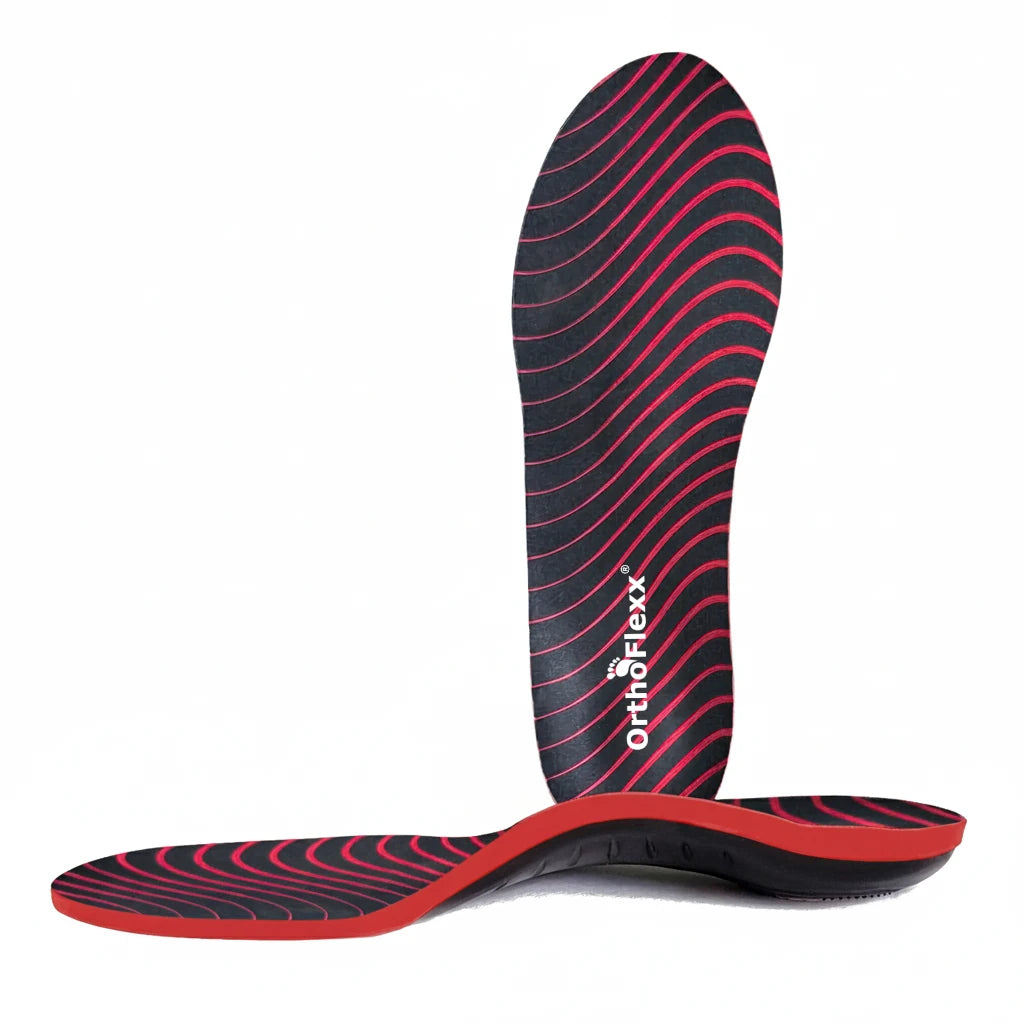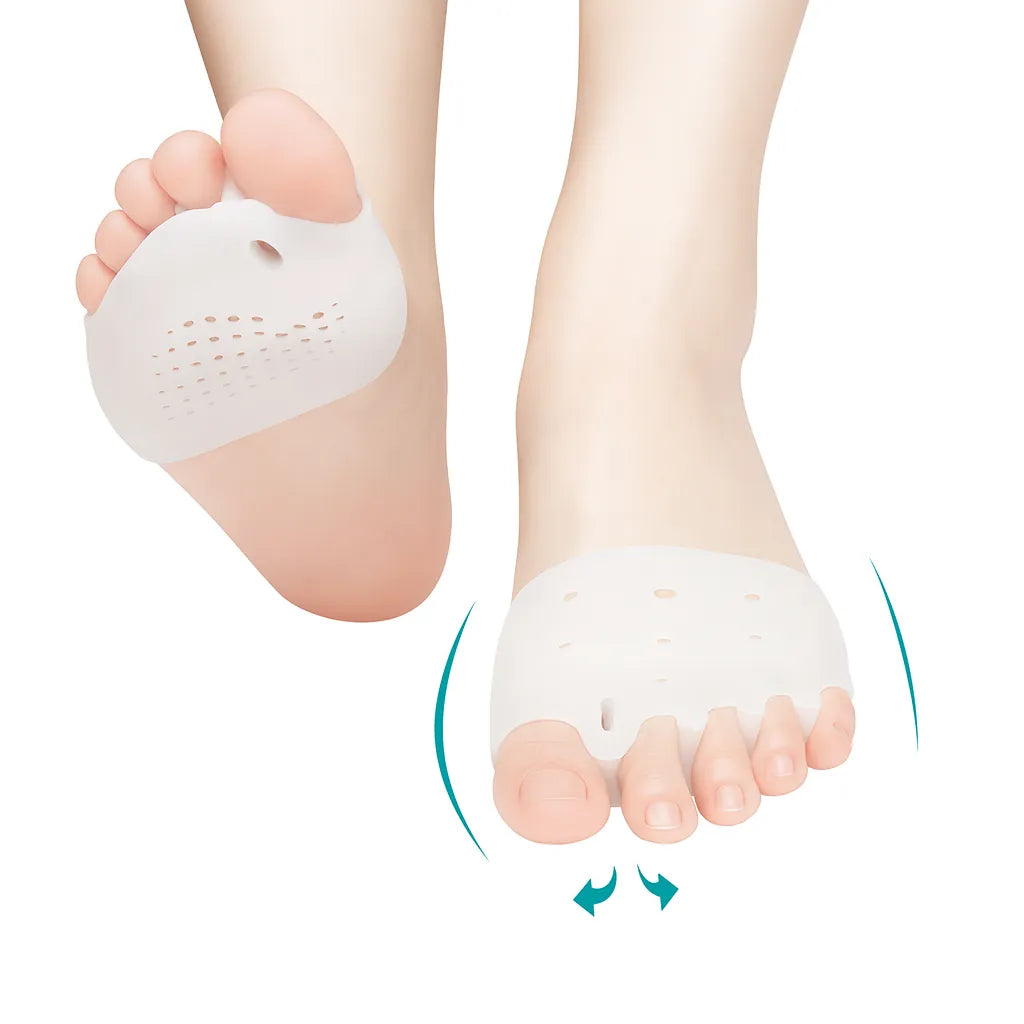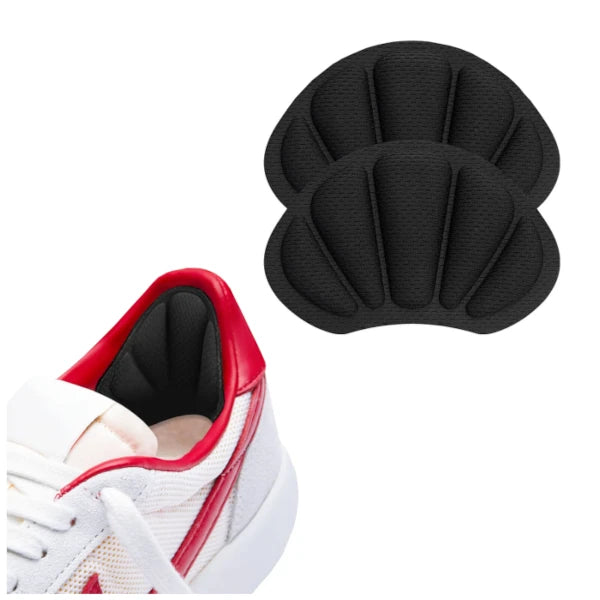
Understanding Plantar Fasciitis: Causes and Symptoms
Share
Plantar fasciitis, a common foot condition, can be a real pain - quite literally. The cause? Repetitive strain on the plantar fascia tissue. This thin band of tissue, akin to a stretched-out rubber band, supports the arch of your foot. But when it's overworked or damaged, it can lead to excruciating heel pain that feels like stepping on a bed of nails.

Imagine waking up in the morning with sharp pain shooting through your heel as you take those first steps. That's one of the main symptoms of plantar fasciitis. It's like a cruel wake-up call from your own body, reminding you that something isn't right down there.
But don't fret just yet! So grab a seat (or prop up your feet if they're achy), because we're about to unravel this perplexing condition.
Understanding the Causes of Plantar Fasciitis
Plantar fasciitis is a common condition that causes heel pain and discomfort. It occurs when the plantar fascia, a thick band of tissue that connects the heel bone to the toes, becomes inflamed. Understanding the causes of plantar fasciitis can help individuals take preventive measures and seek appropriate treatment if necessary.
Overuse or Excessive Physical Activity
One of the primary causes of plantar fasciitis is overuse or excessive physical activity. Engaging in activities that put repetitive stress on the feet, such as running, dancing, or jumping, can strain the plantar fascia. This constant stress can lead to micro-tears in the ligament and result in inflammation and pain.
Being Overweight or Obese
Being overweight or obese increases the risk of developing plantar fasciitis. The additional weight places extra pressure on the feet, causing increased stress on the plantar fascia ligament. This added strain can contribute to its inflammation and subsequent pain.
Flat Feet or High Arches
Having flat feet or high arches can also contribute to the development of plantar fasciitis. In individuals with flat feet (low arches), there is less natural shock absorption during walking or running, putting more tension on the plantar fascia. On the other hand, high arches can create an imbalance in weight distribution, leading to increased tension on specific areas of the foot and also causing irritation to the plantar fascia.
Understanding these causes allows individuals to identify potential risk factors for developing plantar fasciitis and take appropriate steps to prevent it:
- Wearing supportive footwear: Choosing shoes with proper arch support and cushioning can help reduce tension on the plantar fascia.
- Gradually increasing physical activity: Avoid sudden increases in intensity or duration when participating in sports or exercise routines.
- Maintaining a healthy weight: By maintaining a healthy weight, individuals can alleviate excessive pressure on the feet and reduce the risk of plantar fasciitis.
It is important to note that while these factors increase the likelihood of developing plantar fasciitis, they do not guarantee its occurrence. Some individuals may have multiple risk factors but never experience symptoms, while others may develop plantar fasciitis without any known risk factors.
Identifying the Symptoms of Plantar Fasciitis
Plantar fasciitis can be a real pain in the foot, quite literally. If you're experiencing intense heel pain, especially when taking those first steps in the morning, there's a good chance it could be plantar fasciitis. Let's dive into the symptoms to help you understand what you might be dealing with.
Morning Heel Pain and More
The most common symptom of plantar fasciitis is intense heel pain, particularly during those initial steps after getting out of bed in the morning. It feels like someone is stabbing your heel with a knife! This sharp pain is caused by inflammation and irritation of the plantar fascia, a thick band of tissue that connects your heel bone to your toes.
But wait, there's more! Pain may also strike after prolonged periods of rest or standing. So if you've been sitting for a while and then suddenly get up to walk, brace yourself for some discomfort. The culprit behind this agony is the tightening and shortening of the plantar fascia when it's not being used.
Swelling and Tenderness
In addition to heel pain, some individuals with plantar fasciitis may experience swelling and tenderness in the affected area. The foot might feel warm to touch due to increased blood flow as your body tries to heal itself. This swelling can make walking even more challenging and painful.
Other Telltale Signs
Apart from these primary symptoms, there are a few other indicators that could point towards plantar fasciitis:
- Changes in Gait: You may notice changes in how you walk or run due to compensating for the pain in your foot.
- Calf Tightness: The calf muscles might feel tight or stiff since they work closely with the plantar fascia.
- Nerve Damage: In rare cases, severe compression on nearby nerves can lead to tingling or numbness in the toes.
- Heel Spurs: Although not directly causing plantar fasciitis, heel spurs (bony growths on the heel) can be associated with this condition and contribute to the pain.
- Morning Stiffness: Your foot may feel stiff and rigid when you wake up, making those first steps even more uncomfortable.
Seeking Help for Plantar Fasciitis
If you're experiencing any of these symptoms, it's essential to consult a healthcare professional for an accurate diagnosis. They can evaluate your symptoms, examine your foot and ankle, and recommend appropriate treatment options.
Remember that early intervention is key. Ignoring plantar fasciitis symptoms or hoping they'll go away on their own can lead to prolonged pain and further complications. So don't hesitate to seek help if you suspect you have plantar fasciitis.
Understanding the symptoms of plantar fasciitis is crucial for timely diagnosis and effective treatment. By recognizing the signs such as morning heel pain, swelling, tenderness, gait changes, calf tightness, or nerve damage, you'll be better equipped to address the issue head-on. Don't let plantar fasciitis keep you off your feet - take action and get back on track!
Exploring Treatment Options for Plantar Fasciitis
Resting and Avoiding Activities that Worsen Symptoms
Resting is a crucial aspect of treating plantar fasciitis. It's important to give your feet a break from activities that exacerbate the pain. This means taking a step back from high-impact exercises like running or jumping, as well as avoiding prolonged periods of standing or walking. By giving your feet time to rest, you allow the inflamed tissues in the plantar fascia to heal.
Stretching Exercises to Alleviate Pain and Improve Flexibility
Stretching exercises can be highly beneficial in managing plantar fasciitis symptoms. These exercises help to stretch and strengthning the muscles and tendons in the foot, relieving tension on the plantar fascia. Simple stretches like calf and towel stretches, or strength exercises like toe curls can be performed at home or under the guidance of a physical therapist.
Some effective stretching techniques include:
- Calf Stretches: Stand facing a wall with one leg forward and slightly bent while keeping the other leg straight behind you. Lean forward until you feel a stretch in your calf muscle.
- Toe Curls: Sit on a chair with your feet flat on the ground. Use your toes to grip a towel and pull it towards you.
- Towel Stretches: Sit on the floor with your legs extended in front of you. Loop a towel around the ball of your foot and gently pull back on both ends of the towel.

Wearing Supportive Shoes with Proper Arch Support
Proper footwear plays an essential role in managing plantar fasciitis symptoms. Look for shoes that provide adequate arch support, cushioning, and stability. Orthotic inserts or shoe inserts can also be used to enhance support and relieve pressure on the plantar fascia.
Consider these factors when selecting shoes:
- Arch Support: Look for shoes that offer arch support to help distribute pressure evenly across the foot.
- Cushioning: Shoes with cushioning in the heel and forefoot can absorb shock and reduce impact on the plantar fascia.
- Stability: Opt for shoes with a firm heel counter and good overall stability to prevent excessive pronation or supination.
Other Treatment Options
In addition to rest, stretching exercises, and proper footwear, there are other treatment options available for plantar fasciitis. These options may be recommended by healthcare professionals based on the severity of your condition:
- Physical Therapy: A physical therapist can guide you through specific exercises and techniques to strengthen the muscles in your feet and legs, improve flexibility, and reduce pain.
- Shock Wave Therapy: This non-invasive treatment involves using sound waves to stimulate healing in the affected area. It has shown promising results in reducing pain and promoting tissue repair.
- Medication: Over-the-counter nonsteroidal anti-inflammatory drugs (NSAIDs) like ibuprofen can help alleviate pain and reduce inflammation. In some cases, corticosteroid injections may be prescribed by a healthcare professional for more severe symptoms.
- Night Splints or Boot Casts: These devices are worn while sleeping to keep the foot flexed upward, stretching the plantar fascia overnight. They can help relieve morning pain caused by tightness in the fascia.
Understanding these treatment options is essential when managing plantar fasciitis symptoms. Remember that each individual's experience with this condition may vary, so it's important to consult with a healthcare professional who can provide personalized advice tailored to your needs.
Nonsurgical and Surgical Treatments for Plantar Fasciitis
Nonsteroidal anti-inflammatory drugs (NSAIDs)
To reduce inflammation and relieve pain associated with plantar fasciitis, doctors may prescribe nonsteroidal anti-inflammatory drugs (NSAIDs). These medications help to alleviate discomfort and improve mobility by reducing swelling in the affected area. NSAIDs are available over-the-counter or can be prescribed at higher doses by a healthcare professional.
Physical therapy sessions
Physical therapy is an effective treatment option for plantar fasciitis. By attending regular physical therapy sessions, individuals can strengthen the muscles in their feet and improve flexibility, which can aid in reducing pain and preventing future injuries. Physical therapists may recommend exercises such as calf stretches, toe curls, and arch strengthening exercises to target the specific areas affected by plantar fasciitis.
Extracorporeal shock wave therapy (ESWT)
Extracorporeal shock wave therapy (ESWT) is a noninvasive treatment option that stimulates healing in the affected ligament. During ESWT, high-energy sound waves are directed towards the heel area to promote tissue regeneration and reduce inflammation. This procedure is typically performed on an outpatient basis and has shown promising results in relieving pain associated with plantar fasciitis.
Injections
In some cases, healthcare providers may recommend injections to alleviate symptoms of plantar fasciitis. Corticosteroid injections are commonly used to reduce inflammation and provide temporary relief from pain. Platelet-rich plasma (PRP) injections have also gained popularity as a treatment option for plantar fasciitis due to their potential regenerative properties. These injections involve using a concentrated solution derived from the patient's own blood to stimulate healing.
Surgery
Surgery is usually considered a last resort for individuals who have not found relief through nonsurgical treatments. The most common surgical procedure for treating plantar fasciitis is called a plantar fascia release. During this procedure, the tight fascia is partially or completely cut to relieve tension and reduce pain. Surgery may also involve removing any bone spurs that have developed in the heel area.
While surgery can provide long-term relief for some individuals, it does come with potential risks and a longer recovery period compared to nonsurgical treatments. It is important to thoroughly discuss the benefits and drawbacks of surgery with a healthcare professional before making a decision.
Prevention Tips to Avoid Plantar Fasciitis
To prevent plantar fasciitis, there are several steps you can take to reduce your risk and protect your feet. Here are some key tips to keep in mind:
Maintain a Healthy Weight
One of the most important factors in preventing plantar fasciitis is maintaining a healthy weight. Excess weight puts additional stress on your feet, increasing the strain on the plantar fascia. By shedding those extra pounds, you can decrease the pressure on your feet and lower your risk of developing this painful condition.
Wear Appropriate Footwear
Choosing the right footwear is crucial for preventing plantar fasciitis. Opt for shoes that provide proper support and cushioning for your feet. Look for shoes with good arch support and shock-absorbing soles. If needed, consider using shoe inserts or orthotic devices to provide additional support and stability. These inserts can help distribute pressure evenly across your foot, reducing strain on the plantar fascia.
Gradually Increase Physical Activity
If you're starting a new exercise routine or planning to increase the intensity or duration of physical activities, it's essential to do so gradually. Sudden changes in activity levels can put excessive strain on your feet and lead to overuse injuries like plantar fasciitis. Start with low-impact exercises such as walking or swimming before progressing to more intense workouts. This gradual approach allows your body time to adapt and reduces the risk of developing foot problems.
Stretch Regularly
Stretching exercises can help improve flexibility in your calf muscles and Achilles tendon, which in turn reduces stress on the plantar fascia. Incorporate stretching into your daily routine by performing calf stretches against a wall or using a towel to stretch out your calf muscles. Rolling a tennis ball underfoot can help massage and stretch the plantar fascia.
Take Breaks When Needed
Avoid prolonged periods of standing or walking on hard surfaces, as this can strain your feet and contribute to plantar fasciitis. If you have a job that requires long hours on your feet, try to take regular breaks to rest and elevate your feet. This allows the plantar fascia to recover and reduces the risk of overuse injuries.
Incorporating these prevention tips into your daily routine can significantly decrease your risk of developing plantar fasciitis. By maintaining a healthy weight, wearing appropriate footwear, gradually increasing physical activity, stretching regularly, and taking breaks when needed, you'll be taking proactive steps towards protecting your feet from this painful condition.
Diagnosis and Tests for Plantar Fasciitis
To properly diagnose plantar fasciitis, a healthcare professional will typically rely on a physical examination and medical history. These initial steps can provide valuable insights into the individual's symptoms and potential causes of heel pain. X-rays or other imaging tests are generally not required unless there is suspicion of an underlying condition beyond plantar fasciitis.
During the physical examination, the healthcare provider may palpate the affected area to assess tenderness and inflammation in the plantar fascia. They may also evaluate the range of motion in the foot and ankle to identify any limitations or abnormalities. By discussing the patient's medical history, including their daily activities and footwear choices, doctors can gain a better understanding of potential risk factors for developing plantar fasciitis.
While imaging tests are not typically necessary for diagnosing plantar fasciitis, they may be used in certain cases. For example, if there is uncertainty about the diagnosis or if another condition is suspected, an ultrasound may be recommended. This non-invasive procedure allows healthcare professionals to visualize the plantar fascia directly. It can help rule out other causes of heel pain such as stress fractures or nerve entrapment.
In some instances, magnetic resonance imaging (MRI) may be utilized to obtain more detailed images of the foot structures. However, this is less common and usually reserved for cases where conservative treatments have failed or when surgery is being considered.
It's important to note that while these tests can provide additional information, they are not always definitive in diagnosing plantar fasciitis. The diagnosis primarily relies on clinical evaluation by a healthcare professional who specializes in foot conditions.
By relying on a combination of physical examination findings, medical history assessment, and sometimes imaging tests like ultrasounds or MRIs when necessary, healthcare professionals can accurately diagnose plantar fasciitis and differentiate it from other conditions causing similar symptoms.
Understanding how plantar fasciitis is diagnosed can help individuals seek appropriate treatment and management strategies. If you are experiencing persistent heel pain, it is crucial to consult with a healthcare professional for an accurate diagnosis and personalized treatment plan.
Managing Plantar Fasciitis for Pain Relief
Now that you have a better understanding of the causes and symptoms of plantar fasciitis, it's time to explore ways to manage the pain and find relief. Remember, you don't have to suffer in silence. By taking proactive steps, you can alleviate discomfort and get back on your feet.
One effective method is to incorporate stretching exercises into your daily routine. These exercises help strengthen the muscles in your feet and calves while increasing flexibility. Wearing supportive shoes with proper arch support can provide much-needed relief. Consider investing in orthotic inserts or custom-made shoe inserts for added comfort.
It's important to remember that every individual is unique, and what works for one person may not work for another. Don't hesitate to consult with a healthcare professional who specializes in foot conditions like plantar fasciitis. They can provide personalized recommendations based on your specific needs and lifestyle.
FAQs
What are some home remedies I can try for plantar fasciitis?
There are several home remedies you can try to alleviate the pain of plantar fasciitis. Some options include applying ice packs to reduce inflammation, using over-the-counter pain relievers, doing foot massages with essential oils, and practicing self-care techniques such as resting and elevating your feet.
Can I still exercise if I have plantar fasciitis?
While high-impact activities may exacerbate the pain of plantar fasciitis, there are still exercise options available. Low-impact activities like swimming or cycling can be less stressful on your feet while allowing you to stay active.
How long does it take for plantar fasciitis to heal?
The healing process for plantar fasciitis varies from person to person. With proper treatment and care, most individuals experience significant improvement within a few months. However, severe cases may require longer periods of time to heal fully.
Are there any lifestyle changes I should consider to manage plantar fasciitis?
Yes, making certain lifestyle changes can help manage plantar fasciitis. It's important to maintain a healthy weight to reduce excess pressure on your feet. Wearing supportive footwear and avoiding prolonged periods of standing or walking on hard surfaces can also make a significant difference.
Can plantar fasciitis come back after it has been treated?
Unfortunately, there is a possibility of plantar fasciitis recurring even after successful treatment. It's crucial to continue with preventive measures such as regular stretching exercises, wearing proper footwear, and listening to your body's signals. If you experience any symptoms again, consult with a healthcare professional for guidance.
Author Bio

Marlene Carvalho
Certified Sports Physiotherapist of Elite and Olympic athletes; Performance Coach to racing drivers
Marlene Carvalho is a sports physiotherapist passionate about all things sports.













